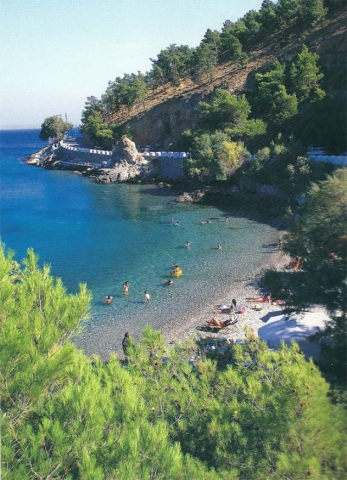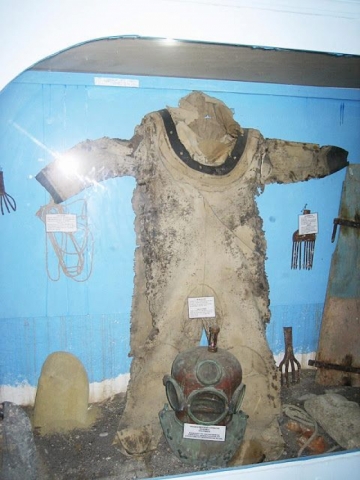Press here.
Prefecture: Dodecanese

Places near Agios Georgios Monastery
Pothia is the capital and also the port of Kalymnos. The construction of Pothia began in early 1850, when pirate raids started to occur less and less often. As a result, the people who lived by then in the Castle of Chora, seeking for protection against the pirates, began progressively to build their homes out of the Castle.
The houses are built in amphitheatrical formation, facing the sea, and are separated from each other by narrow alleys. As you walk in them, you can witness the Italian influence and also the clearly visible details of neoclassical architecture on the traditional buildings. Most traditional houses are encountered in the districts Ypapandi, Hevangelistria, Agios Theologos and Patithries.
Today, Pothia is the administrative and commercial center of the island, where you will find all the public services such as the police, the post office, the port authority, the hospital etc. There are also many facilities for visitors, such as taverns, restaurants, cafes, bakeries and hotels.
In Pothia, you can visit the Archaeological Museum of Kalymnos, which presents the history of the island and hosts various treasures that have been occassionally retrieved from the bottom of the sea, and the Nautical Museum, which presents everything related to the great Kalymnian maritime activity and the sponge catching, with exhibits from ancient shipwrecks ships.
Another interesting venue in Pothia is the Vouvalis' family Mansion, where you will get a taste of the Kalymnian urban architecture.
In Pothia's waterfront, it is placed the Cathedral of the Transfiguration of Jesus Christ. Over there, it is worth seeing the magnificent marble temple, which was crafted by the great Greek sculptor Giannoulis Chalepas. Many churches in Pothia and Kalymnos in general, are adorned with works of great Kalymnianpainters such as S. Magglis, M. Alahouzos, G. Economou, T. Kourounis, N. Maggos, T. Billiris, E. Choulis. and S. Pizanias.
Several beaches are found close to Pothia, one of them being Therma, an area of hot springs that have healing properties.
The beach Gefira is next to Therma and is one of the main beaches of Pothia.
It is a small but beautiful beach with pebbles, rocks and vegetation. The sea water is turquoise and very clean.
Vlychadia is located in the southern part of Kalymnos, just 5 kilometers away from the capital Pothia. The beautiful seaside scenery, the wonderful beaches and the plethora of traditional tavernas and cafes will ensure your beautiful moments of relaxation and recreation.
In Vlychadia you can visit the privately owned Marine Life and Findings Museum, where you will see exhibits relative to sponge catching and various objects from the depths of the Mediterranean.
It is also worth visiting the Kefalas cave (or 'Cave of Zeus'), the most beautiful cave of Kalymnos, located only two kilometers southwest of Vothynoi. Sea trips are held daily to the cave, by boats that depart from the port of Pothia. Alternatively you can go to the cave by following the path that passes in front of the Monastery of St. Catherine.
The beach Vlychadia is a little farther from Pothia (5 kilometers away). Vlychadia actually consists of two different beaches, a pebbly one and a sandy one.
Both of them are relatively shallow and therefore particularly suitable for families with young children. In Vlychadia you will find enough trees for shade after your dives, and rooms, restaurants and cafes.
The people who love action can visit the diving center, where courses are offered to the friends of the -famous to the fishing and snorkeling fans- Kalymnian seabed.
The Maritime Museum of Kalymnos was founded in 1994. It presents the naval tradition, history and methods of the sponge catching, along with many artifacts from ancient shipwrecks. In its four rooms you will see objects related to the profession of sponge catching and sponge processing.
In the Maritime Museum you will learn the diving techniques applied and you will see the equipment used by the sponge catchers, from the beginning of the 19th century until today. You will also find exposed "skandalopetres", which are stones that facilitate the sinking of the divers, tools for sponge processing, maritime instruments (e.g. sextant, compass, barometer), diving suits and air pumps.
A rich collection of photographs from the beginning of the 20th century depict the city and the events that took place during the departure of sponge catchers, demonstrating thus how inextricably connected was the Kalymnian social life with sponge catching.
The exposed items include also anchors made of stone, lead and iron, nautical charts from the 16th-17th century, various findings from shipwrecks, stone cannonballs, ship rigging, nautical lanterns and boat miniatures.
Finally, you can see traditional costumes, dishes, scarves, musical instruments, antique furniture, linens, pillows, textiles, weaving accessories, items for the kneading of bread and jugs that were used in the Kalymnian households in the past.
The Traditional House of Kalymnos is a privately held folk museum, founded by Mrs. Scylla - Chalkidiou. The aim of the museum is to preserve and promote the Kalymnian lifestyle of the past century. It is located on the southern outskirts of Agioi Pantes Monastery, in the area Vothynoi, and includes objects of folk culture and old household furniture.
The museum is actually a restored traditional house in which you will find artifacts collected from across the island. They are exposed in a way that helps revive the story of a traditional urban house of the late 19th and early 20th century. Here you will travel back in time, by observing the main daily activities, the social events and of course the legendary life of the Kalymnian sponge catcher!
In this lovely home you will see, among others, traditional costumes, everyday utilitarian objects and representations of household activities and tasks.
The museum is open daily from 8:30 to 14:00. For more information please contact the museum on 22430 51635.
This is a private museum, a life's work of Valsamidis brothers, who were born and live in Kalymnos. Their love for the sea and the willingness to share its joys and wealth with other people, lead them build this museum with enormous personal effort and enthusiasm. The result of their work will impress you.
The findings, which have been collected after thousands of divings in the sea all around the world, include almost anything that can be found on the seabed; fish, shells, shellfish, starfish, corals, sharks, turtles and tortoises, and of course all kinds of sponges.
Part of the museum is dedicated to the profession of sponge collectors. In these rooms you will see the tools and diving suits that were used by scuba divers from 1872 until today.
In a separate wing findings of the WWI and WWII are exhibited, such as torpedoes, pieces of planes etc while in a specially designed area jars of 6th, 4th, 3rd and 2nd BC century are being kept.
In the museum there is also a collection of about 2000 photographs that demonstrate the history and the traditions of the sponge collectors. In the museum you will also witness the sponge processing and you may find nice souvenirs such as sponges, corals and shells in the store that operates within.





